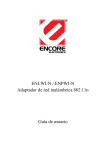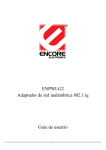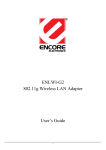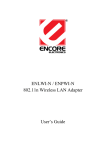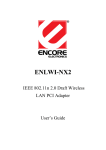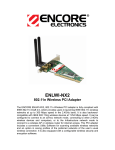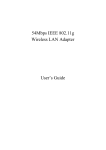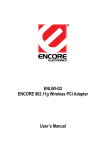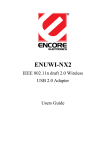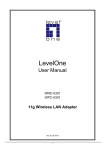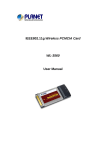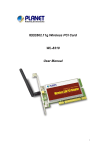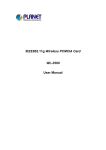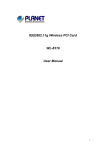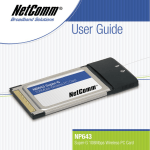Download ENCORE ENPWI-G2
Transcript
ENLWI-G2 / ENPWI-G2 802.11g Wireless LAN Adapter User’s Guide Regulatory notes and statements Wireless LAN, Health and Authorization for use Radio frequency electromagnetic energy is emitted from Wireless LAN devices. The energy levels of these emissions however are far much less than the electromagnetic energy emissions from wireless devices like for example mobile phones. Wireless LAN devices are safe for use frequency safety standards and recommendations. The use of Wireless LAN devices may be restricted in some situations or environments for example: ·On board of airplanes, or ·In an explosive environment, or ·In case the interference risk to other devices or services is perceived or identified as harmful In case the policy regarding the use of Wireless LAN devices in specific organizations or environments (e.g. airports, hospitals, chemical/oil/gas industrial plants, private buildings etc.) is not clear, please ask for authorization to use these devices prior to operating the equipment. Regulatory Information/disclaimers Installation and use of this Wireless LAN device must be in strict accordance with the instructions included in the user documentation provided with the product. Any changes or modifications made to this device that are not expressly approved by the manufacturer may void the user’s authority to operate the equipment. The Manufacturer is not responsible for any radio or television interference caused by unauthorized modification of this device, of the substitution or attachment. Manufacturer and its authorized resellers or distributors will assume no liability for any damage or violation of government regulations arising from failing to comply with these guidelines. USA-FCC (Federal Communications Commission) statement This device complies with Part 15 of FCC Rules. Operation is subject to the following two conditions: 1. This device may not cause interference, and 2. This device must accept any interference, including interference that may cause undesired operation of this device. i FCC Radio Frequency Exposure statement This Wireless LAN radio device has been evaluated under FCC Bulletin OET 65 and found compliant to the requirements as set forth in CFR 47 Sections 2.1091, 2.1093, and 15.247 (b) (4) addressing RF Exposure from radio frequency devices. The radiated output power of this Wireless LAN device is far below the FCC radio frequency exposure limits. Nevertheless, this device shall be used in such a manner that the potential for human contact during normal operation is minimized. When nearby persons has to be kept to ensure RF exposure compliance, in order to comply with RF exposure limits established in the ANSI C95.1 standards, the distance between the antennas and the user should not be less than 20 cm. FCC Interference Statement This equipment has been tested and found to comply with the limits for a Class B digital device, pursuant to Part 15 of the FCC Rules. These limits are designed to provide reasonable protection against harmful interference in a residential installation. This equipment generates, uses, and can radiate radio frequency energy. If not installed and used in accordance with the instructions, it may cause harmful interference to radio communications. However, there is no guarantee that interference will not occur in a particular installation. If this equipment does cause harmful interference to radio or television reception, which can be determined by turning the equipment off and on, the user is encouraged to try and correct the interference by one or more of the following measures: 1. Reorient or relocate the receiving antenna. 2. Increase the distance between the equipment and the receiver. 3. Connect the equipment to an outlet on a circuit different from that to which the receiver is connected. 4. Consult the dealer or an experienced radio/TV technician for help. Export restrictions This product or software contains encryption code that may not be exported or transferred from the US of Canada without an approved US Department of Commerce export license. ii Safety Information Your device contains a low power transmitter. When device is transmitted it sends out radio frequency (RF) signal. CAUTION: To maintain compliance with FCC’s RF exposure guidelines, this equipment should be installed and operated with minimum distance 20cm between the radiator and your body. Use on the supplied antenna. Unauthorized antenna, modification, or attachments could damage the transmitter and may violate FCC regulations. The antenna(s) used for this transmitter must be installed to provide a separation distance of at least 20 cm from all persons and must not be co-located or operating in conjunction with any other antenna or transmitter. CE Mark Warning This is a Class B product. In a domestic environment, this product may cause radio interference, in which case the user may be required to take adequate measures. Protection requirements for health and safety – Article 3.1a Testing for electric safety according to EN 60950 has been conducted. These are considered relevant and sufficient. Protection requirements for electromagnetic compatibility – Article 3.1b Testing for electromagnetic compatibility according to EN 301 489-1, EN 301 48917 and EN 55024 has been conducted. These are considered relevant and sufficient. Effective use of the radio spectrum – Article 3.2 Testing for radio test suites according to EN 300 328-2 has been conducted. These are considered relevant and sufficient. CE in which Countries where the product may be used freely: Germany, UK, Italy, Spain, Belgium, Netherlands, Portugal, Greece, Ireland, Denmark, Luxembourg, Austria, Finland, Sweden, Norway and Iceland. France: except the channel 10 through 13, law prohibits the use of other channels. iii TABLE OF CONTENT Introduction.......................................................................................................1 Overview of this User’s Guide .......................................................................1 Unpacking and Setup ........................................................................................3 Unpacking.......................................................................................................3 Setup ...............................................................................................................3 Hardware Installation ........................................................................................5 LED Indicator for CardBus ............................................................................5 LED Indicator for PCI ....................................................................................5 Check the installation .....................................................................................5 Software Installation .........................................................................................7 Utility and Driver Installation using Adapter Setup Wizard ..........................7 Windows 98/ME/2000/XP/Vista Utility and Driver Installation....................8 Wireless Utility Setting .....................................................................................9 Link Information.............................................................................................9 Configuration................................................................................................10 Advanced......................................................................................................12 Site Survey....................................................................................................14 About ............................................................................................................15 Technical Specifications .................................................................................17 FAQ.................................................................................................................18 INTRODUCTION Congratulations on your purchase of this Encore 802.11g Wireless LAN Adapter. This manual helps to get familiar with Encore 802.11g Wireless LAN Adapter. This manual contains detailed instructions in operation of this product. Please keep this manual for future reference. With a Wireless LAN Adapter, a laptop computer or a station can communicate with another computer in a wireless way. Easy-to-use utilities are bundled with Wireless LAN Adapter for configuration, monitoring, and diagnosis purposes. Wireless LAN Adapter can wirelessly transmit and receive data, with the Wireless LAN Adapter, you can locate your Notebook PC or station wherever you want without wires and cables. Wireless LAN Adapter provides users with an access to real-time information anywhere in their organization. The mobility provides productivity and service, which are not available under wired networks. The Wireless LAN Adapter configuration is easy to change from peer-to-peer networks, suitable for a small number of users, to full infrastructure networks of thousands of users that allow roaming around a broad area. Overview of this User’s Guide Introduction. Describes Encore 802.11g Wireless LAN Adapter. Unpacking and Setup. Helps you get started with the basic installation of Encore 802.11g Wireless LAN Adapter. Hardware Installation. Describes the LED indicators of Encore 802.11g Wireless LAN Adapter. Software Installation. Tells how to setup the driver and the utility setting. Technical Lists the technical (general, physical and environmental) Specifications. specifications of Encore 802.11g Wireless LAN Adapter. 1 UNPACKING AND SETUP This chapter provides unpacking and setup information for Encore 802.11g Wireless LAN Adapter. Unpacking Open the box of Encore 802.11g Wireless LAN Adapter and carefully unpack it. The box should contain the following items: One 54Mbps IEEE 802.11g Wireless LAN Adapter One Driver & Utility with User’s Guide CD-ROM If any item is found missing or damaged, please contact your local reseller for replacement. Setup The setup of the Wireless LAN Adapter can be performed using the following steps: Visually inspect the CardBus/PCI Adapter and make sure that it is fully plugged in to the CardBus/PCI slot. Make sure that there is a well environment that there is no much intrusion to have a better connection. 3 HARDWARE INSTALLATION LED Indicator for CardBus Link The Link LED indicator lighted green when Encore 802.11g Wireless LAN Adapter is connected to wireless network successfully. ACT (Activity) The ACT LED indicator blinking green when Encore 802.11g Wireless LAN Adapter is transmitting or receiving data. LED Indicator for PCI Link The Link LED indicator lighted green when Encore 802.11g Wireless LAN Adapter is connected to wireless network successfully. Check the installation The LEDs of the Wireless LAN Adapter are clearly visible and the status of the network link can be seen instantly: 1. Once the device is plugged to the station’s CardBus/PCI slot, the LED of the Wireless LAN Adapter will light up indicating a normal status. 2. When the device plugged to the station’s CardBus/PCI slot and the driver was installed, the ACT will start alternate blinking, it means that the device is starting to scan the wireless devices near the Wireless LAN Adapter. 3. While the Wireless LAN Adapter linked up and transmitting data to the Access Point or to other Wireless LAN station, the Link LED will lighted green. 5 SOFTWARE INSTALLATION This section will lead you to install the driver and utility of the Wireless LAN Adapter. Utility and Driver Installation using Adapter Setup Wizard (for ENPWI-G2 running Windows 2000/XP Vista only) 1. Insert Encore 802.11g Wireless LAN Adapter Driver & Utility CD-ROM into computer’s CD-ROM Drive and it will automatically run a setup menu. Choose Wizard on the bottom left-hand corner and follow the on-screen instruction to set up the adapter. 7 Windows 98/ME/2000/XP/Vista Utility and Driver Installation 1. Insert Encore 802.11g Wireless LAN Adapter Driver & Utility CD-ROM into computer’s CD-ROM Drive and it will automatically run a setup menu and install the driver and the utility. In some specific setting on Windows system, you may need to proceed the software manually, go to your Windows Start menu and choose Run, type “D:\Setup.exe” in the dialog box (D:\ will depend on where your CD-ROM drive is located) and click OK. 2. If you need to install the driver manually, refer each Windows OS to the following CD-Rom directory path: D:\Driver\<Windows OS>. Note: (D:\ will depends on where the CD-ROM drive is located and <Windows OS> will depend on the Windows OS you are using). 3. The Install Shield Wizard screen will appear. Click “Next” to continue. 4. The installation program will help you to setup the Wireless LAN utility. Be noted that the Windows XP have its own Wireless Utility; you can either use the utility of Windows XP or the provided utility. 5. When the Wireless LAN Adapter was installed, you will see the icon on the Windows task bar. When the icon in the toolbar represents in full green color then the signal strength has an excellent performance with the AP, if it represents in yellow color then the signal strength has a fair performance with the AP, and if the icon represents no color, then the signal strength has a worst performance with the wireless station. 8 WIRELESS UTILITY SETTING Link Information The default page is as below after launching the Utility program. Status: Shows the BSSID associated, which can be used to identify the wireless network. SSID: Shows current SSID, which must be the same for the wireless client and AP in order for communication to be established. Frequency: Shows the current frequency used for wireless network. Wireless Mode: Shows the current wireless mode used for wireless communication. Encryption: Shows the current encryption mode used for wireless network. TxRate: Shows the current data rate used for transmitting. Channel: Shows the current channel for communication. Link Quality: Shows the link quality of the wireless LAN adapter with the Access Point when operating under Infrastructure mode. Signal Strength: Shows the wireless signal strength of the connection between the wireless LAN adapter card with the Access Point. Data Rate: Shows the statistics of data transfer, and the calculation is based on the number of packets transmitted and received. 9 Configuration This is the page where changes the basic settings of the wireless LAN adapter with the minimum amount of effort to implement a secure wireless network environment. SSID: Service Set Identifier, which is a unique name shared among all clients and nodes in a wireless network. The SSID must be identical for each clients and nodes in the wireless network. Wireless Mode: There are two types available for selection ●Infrastructure – to establish wireless communication with LAN and other wireless clients through the use the Access Points. ●Ad-Hoc – to establish point-to-point wireless communication directly with other wireless client devices such as wireless network PCI Adapter. AdHoc Band: When using Wireless Mode for Ad-Hoc mode, select the AdHoc Band from drop down list for 11b only, 11g only or Auto for both of 11b and 11g. Channel: The value of channel that AP will operate in. User can select the channel range of 1 to 11 for North America (FCC) domain and 1 to 13 for European (ETSI) domain and 1 to 14 for Japanese domain. 10 Power Mode: There are 3 modes to choose. • Continuous Access Mode (default) – the wireless LAN adapter is constantly operating with full power and it consumes the most power. • Maximum Power Save – the wireless LAN adapter consumes the least power and only operates when there is wireless network activity. • Power Save – the wireless LAN adapter consumes the moderate level of power. Preamble: Select Long or Short Preamble type. Preamble is a sequence of bits transmitted at 1Mbps that allows the PHY circuitry to reach steady-state demodulation and synchronization of bit clock and frame start. Two different preambles and headers are defined: the mandatory supported Long Preamble and header, which interoperate with the 1 Mbit/s and 2 Mbit/s DSSS specification (as described in IEEE Std 802.11), and an optional Short Preamble and header (as described in IEEE Std 802.11b). At the receiver, the Preamble and header are processed to aid in demodulation and delivery of the PSDU. The Short Preamble and header may be used to minimize overhead and, thus, maximize the network data throughput. However, the Short Preamble is supported only from the IEEE 802.11b (High- Rate) standard and not from the original IEEE 802.11. That means that stations using Short-Preamble cannot communicate with stations implementing the original version of the protocol. Click “Apply” for the changes to take effect. Support Band: There are two functions for users select, including 11B and 11G. The default setting is 11B and 11G are enabled, which is interoperable with both 11B and 11G devices. Note: user must select one of 11B or 11G at least; otherwise the wireless connection will not function. 11 Advanced This is the page to configure Security settings of Encore 802.11g Wireless LAN Adapter. Auth Mode: Select the authentication type from drop down list for Disable, Open System, Shared Key, WPA, WPA-PSK, WPA2 and WPA2-PSK. Open System / Shared Key WEP Key 1~4: choose the encryption way, either in HEX or ASCII formats, and enter the password in the blank space. 12 Key Length: select 64 or 128 bits as the length of the keys. If you select 64bit in Hex format, you must type 10 values in the following range (0~F, hexadecimal), or 64bit in ASCII format, you must type 5 values in the following range (0~9, A~Z and a~z Alphanumeric); If you select 128bit in Hex format, you must type 26 values (0~F, hexadecimal), or 128bit in ASCII format, you must type 13 values in the following range (0~9, A~Z and a~z Alphanumeric). Default Key: select one of the 4 keys to use. Key Format: ASCII or HEX. WPA-PSK / WPA2-PSK If WPA-PSK or WPA2-PSK is selected, the above screen is shown. Please select the encryption type from drop down menu and press Configuration button to configure the passphrase key. Encryption: Select the encryption type for TKIP or AES encryption type. WPA / WPA2 If WPA or WPA2 is selected, the above screen is shown. Please select the encryption type from drop down menu and press Configuration button to configure parameters for the RADIUS server. WARNING:WPA, WPA2 don’t support In Windows 98/ME . Encryption: Select the encryption type for TKIP or AES encryption type. 13 Site Survey This page allows user to enable the Site Survey function to scan for the available wireless network (wireless clients and Access Points) and establish wireless communications with one. Available Network – displays the wireless networks (wireless clients and Access Points) that are in signal range. Select any one of them to establish communications by simply mouse double-click or click on the “Connect” button. Click “Refresh” button to start scanning for available network again. Profile – User can create and manage the created profiles for Home, offices or public areas. By doubleclicking on one of the created profile, the setting will adapt to the configuration such as SSID, channel, and WEP settings saved by that particular profile. Add: To add a profile. Then, the following screen would appear. User can enter the necessary information required for accessing Access Points or Wireless Router. Edit: To view and change its settings of the profile. Remove: To remove the selected profile 14 About This page displays some information about Encore 802.11g Wireless LAN Adapter utility, which includes the version numbers for Driver, Firmware and Utility. When there is new version of software available for upgrade, users will be able to identify by version numbers. 15 TECHNICAL SPECIFICATIONS General Radio Technology IEEE 802.11b Direct Sequence Spread Spectrum (DSSS) IEEE 802.11g Orthogonal Frequency Division Multiplexing (OFDM) Interface PC Card: 32-bit CardBus, PCI Adapter: 32-bit PCI bus Data Transfer Rate 1, 2, 5.5, 6, 9, 11, 12, 18, 24, 36, 48, 54Mbps Receiver Sensitivity 54Mbps: Typical -70dBm @ 10% PER (Packet Error Rate) 11Mbps: Typical -86dBm @ 8% PER (Packet Error Rate) Transmit Power 802.11b: 15±2dBm 802.11g: 13±2dBm Frequency Range 2412 ~ 2484 MHz ISM band (channels 1 ~ 14) Modulation Schemes DBPSK/DQPSK/CCK/OFDM Channels 1~11 channels (FCC), 1~13 channels (ETSI), 1~14 channels (MKK-Japan) Media Protocol Access CSMA/CA with ACK Security 64/128-bits WEP Encryption, WPA-PSK, WPA2-PSK, WPA, WPA2 Diagnostic LED PC Card: Link, ACT, PCI Adapter: Link Antenna PC Card: Integrated printed dual diversity antennas PCI: 2dBi dipole antenna Physical and Environmental Driver Support Windows 98, ME, Windows 2000, Windows XP Temperature Operating: 0° ~ 40° C, Storage: -10° ~ 70° C Humidity 10% ~ 95% RH, no condensation Dimensions PC Card:, 115 x 54 x 8.7 mm, PCI Adapter: 13 x 121 x 21.6 Certifications FCC Part 15.247 for US, ETS 300 328 for Europe, 17 FAQ Q: My wireless signal drops, or my wireless signal strength fluctuates, or I am having problems wirelessly transferring large files, what steps can I take to correct this? A: When the signal strength drops or fluctuates, the common cause is RF interference. • • • • Change the channel on your access point or wireless router. Change the location of your wireless products. Subtle changes (2-3 feet) can make a big difference. Do not put the access point or wireless router in a cabinet or enclosure. 2.4GHz phones, X-10, and bluetooth devices will interfere with your wireless network. Change the location of the base for your phone, or downgrade to 900Mhz phones, or upgrade to 5.2Ghz phones. The wireless signal will degrade (or die completely) when going through brick (fireplace), metal (file cabinet), steel, lead, mirrors, water (fish tank), large appliances, glass, etc. Q: How do I tell if my adapter is installed properly in Windows XP? A: Step 1 Right click My Computer. Step 2 Select Manage Step 3 Click the Device Manager under the System Tools section in the left panel. Step 4 In the right panel, expand the Network Adapters section. Your adapter should show up by name. (ex 802.11g USB 2.0 Wireless LAN Adapter) If there is a problem with installation, the device will display as an Ethernet Controller, Network Controller, Unknown device, or will not be listed at all. Q: The wireless adapter driver and software are installed properly, but it cannot detect nor connect to any wireless station. What can I do? A: Step 1. Inspect wireless utility software Wireless Channel setting, make sure it matches router’s setting. (e.g. if router’s wireless setting is set to channel 6, then the software must be set to channel 6 as well, so on.) Step 2. Make sure in wireless utility software, wireless mode is set to Infrastructure (access point), not Ad-hoc (computer-to-computer) 18 Step 3. Set all TCP/IP settings in your computer to automatic, unless your ISP specifies otherwise. Step 4. Check wireless security key setting in the router; make sure the wireless utility’s key matches it. Q: I have trouble configuring or using Wireless Configuration Utility that comes with the wireless card/adapter. What can I do? A: If you are using Windows XP, we recommend that you use Windows XP’s Wireless Utility (WZC). To do this, go to Start, Control Panel, if it is not already in Classic View, click on “Switch to Classic View” on the left panel, Network Connections, right-click on your Wireless Connection icon and then select “View Available Wireless Networks”, on the left panel select “Change advanced settings”, click on the Wireless Networks tab, make sure “Use Windows to configure my wireless network settings” box is checked, press OK. Now, on the bottom-right corner of the screen you should see a little monitor icon. Right-click on it, choose “View Wireless Networks” to view a list of wireless stations, then double-click on your wireless station to connect to it. If you are not using Windows XP, please remove Wireless Configuration Utility in Control Panel, Add/Remove Program, restart the computer, and reinstall it. 19



























